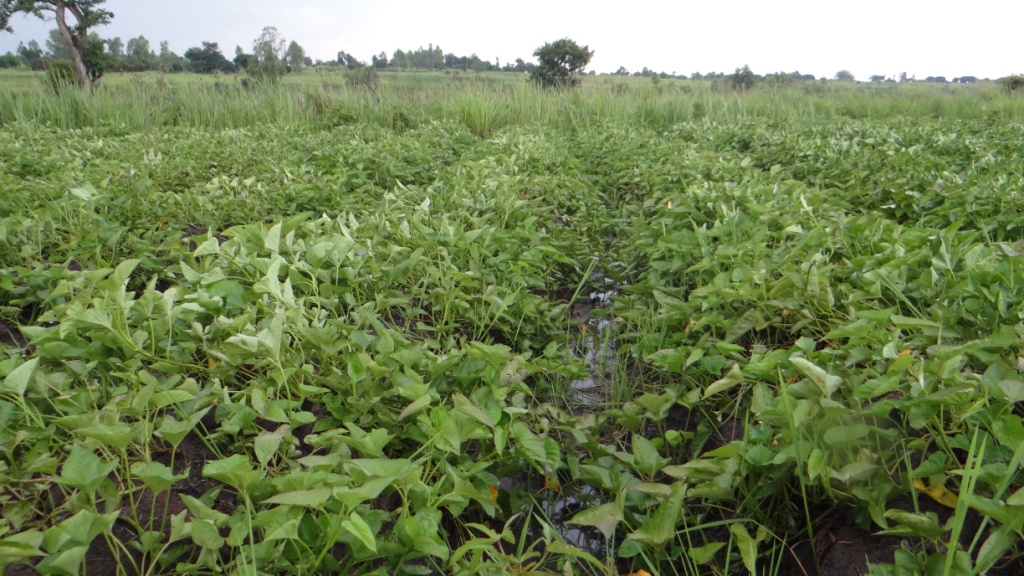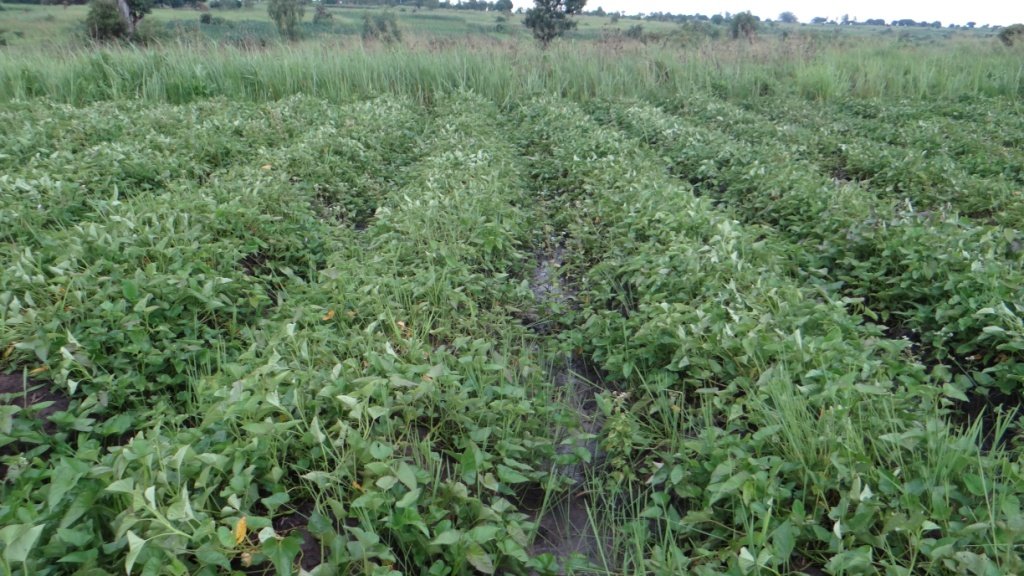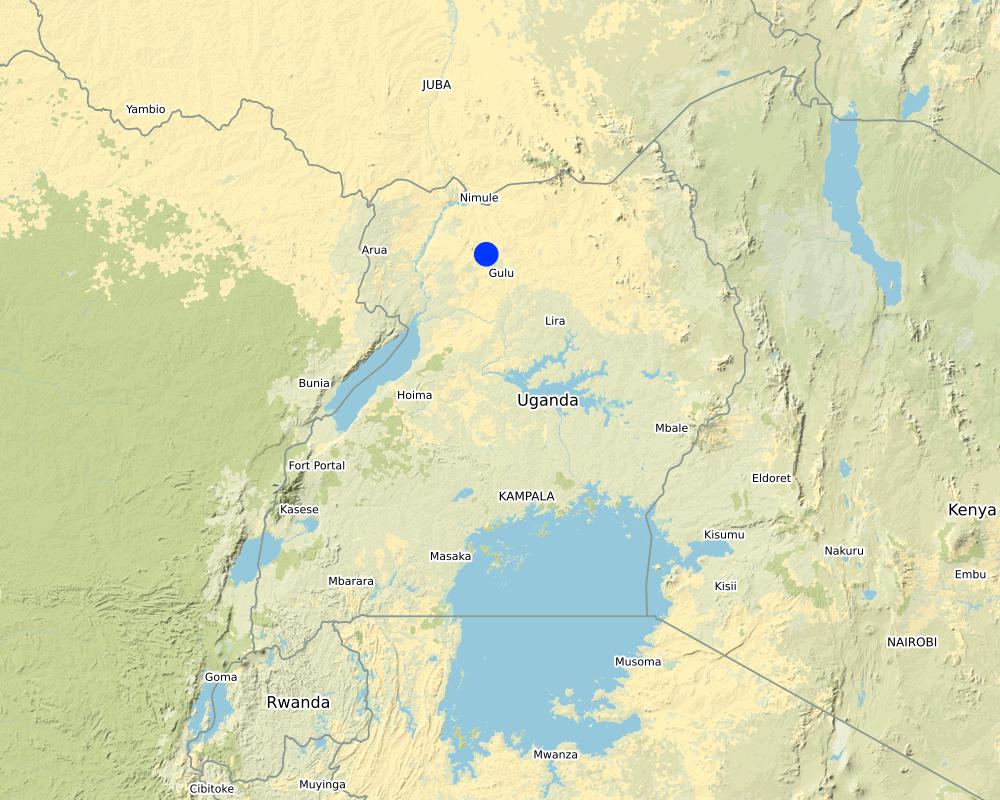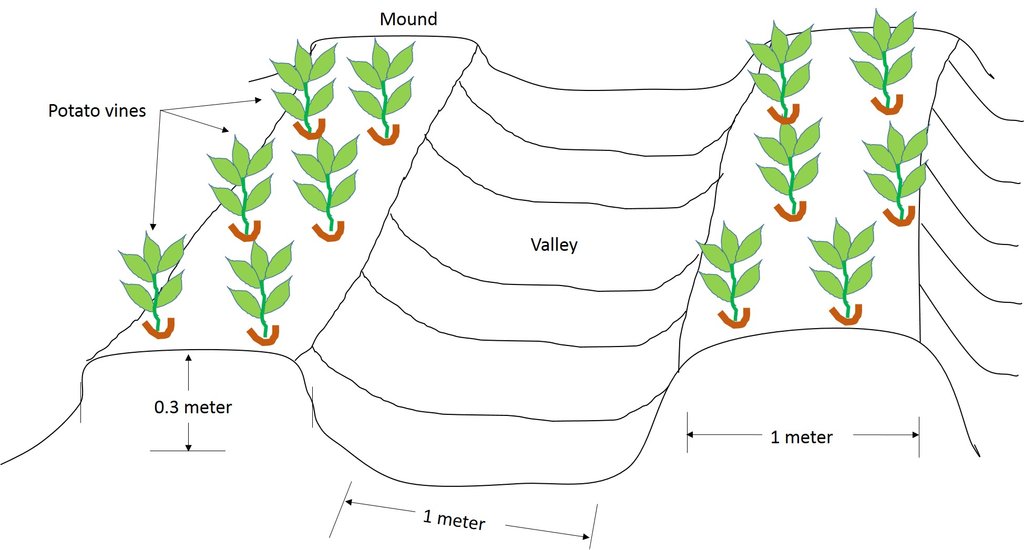Potatoes Gowing in Lowlands for Food Security Durnig Dry Seasons [Uganda]
- Creation:
- Update:
- Compiler: Bernard Fungo
- Editors: JOY TUKAHIRWA, Kamugisha Rick Nelson, betty adoch, Sunday Balla Amale
- Reviewers: Nicole Harari, Udo Höggel
technologies_2886 - Uganda
View sections
Expand all Collapse all1. General information
1.2 Contact details of resource persons and institutions involved in the assessment and documentation of the Technology
Key resource person(s)
land user:
Name of project which facilitated the documentation/ evaluation of the Technology (if relevant)
Scaling-up SLM practices by smallholder farmers (IFAD)Name of the institution(s) which facilitated the documentation/ evaluation of the Technology (if relevant)
CDE Centre for Development and Environment (CDE Centre for Development and Environment) - Switzerland1.3 Conditions regarding the use of data documented through WOCAT
When were the data compiled (in the field)?
25/5/2017
The compiler and key resource person(s) accept the conditions regarding the use of data documented through WOCAT:
Yes
1.4 Declaration on sustainability of the described Technology
Is the Technology described here problematic with regard to land degradation, so that it cannot be declared a sustainable land management technology?
No
2. Description of the SLM Technology
2.1 Short description of the Technology
Definition of the Technology:
Lowlands have relatively high water tables and contain sufficient soil moisture to permit potatoes growing. Potatoes can grow in such areas compared to other staple crops like cassava.
2.2 Detailed description of the Technology
Description:
Northern Uganda is mainly semi-arid, receiving rainfall amounts ranging from 600-1000 mm annually. Under these conditions, cultivation of crops is restricted to drought resistant ones such as cassava, sorghum, simsim and ground nuts. Farmers have realized that potatoes are a potential food security crop because they can endure more soil moisture that is available in the lowlands during the dry season. Thus, cultivation of potatoes in wetlands is becoming common because wetlands retain water for longer periods and potatoes, when cultivated, ensure food security during the dry season, a time when other crops are not available, thus bridging the food deficit months.
Sometimes the water in the swamp is more than the potatoes can tolerate. To address this challenge, mounds are made in the garden and the potato vines are planted on the mound rather than in the valley. The size of the mound is approximately one meter wide. The optimum spacing between mounds is also one meter. Potato vines are planted usually at the start of the dry season because this is when the water in the wetlands begins to recede. This is either in June or December. The vines are obtained from neighboring farmers. Weeding is done by manually removing the weeds with either hands or with a hoe. Most of the cultivars in the area are harvested after four months.
The major benefits of this potato growing is to ensure food availability during the dry season when most crops are not available. It also protects the soil as cover-crop, from soil erosion, food security maintaining the tuber for early planting the next season. The major input needed are tuber, labour and land. The benefits of planting potatoes include preventing soil erosion, food and income security. The land user finds the potato crop easy to manage, maturing faster, and being a source of food and income at the same time. Vines from the potato gardens are also used as forage for cows and goats.
2.3 Photos of the Technology
2.4 Videos of the Technology
Date:
25/5/2017
Location:
Paboo Amuru District
Name of videographer:
Issa Aliga
2.5 Country/ region/ locations where the Technology has been applied and which are covered by this assessment
Country:
Uganda
Region/ State/ Province:
Northern
Further specification of location:
Amuru District
Map
×2.6 Date of implementation
Indicate year of implementation:
2016
2.7 Introduction of the Technology
Specify how the Technology was introduced:
- through land users' innovation
3. Classification of the SLM Technology
3.1 Main purpose(s) of the Technology
- adapt to climate change/ extremes and its impacts
- mitigate climate change and its impacts
3.2 Current land use type(s) where the Technology is applied

Cropland
- Annual cropping
Main crops (cash and food crops):
Potatoes, maize
3.3 Further information about land use
Water supply for the land on which the Technology is applied:
- rainfed
Number of growing seasons per year:
- 2
3.4 SLM group to which the Technology belongs
- rotational systems (crop rotation, fallows, shifting cultivation)
- ground water management
3.5 Spread of the Technology
Specify the spread of the Technology:
- evenly spread over an area
If the Technology is evenly spread over an area, indicate approximate area covered:
- < 0.1 km2 (10 ha)
3.6 SLM measures comprising the Technology

management measures
- M2: Change of management/ intensity level
- M4: Major change in timing of activities
3.7 Main types of land degradation addressed by the Technology

soil erosion by water
- Wt: loss of topsoil/ surface erosion

other
Comments:
Other Land related challenge is climate change in terms of increased dry spells
3.8 Prevention, reduction, or restoration of land degradation
Specify the goal of the Technology with regard to land degradation:
- adapt to land degradation
4. Technical specifications, implementation activities, inputs, and costs
4.1 Technical drawing of the Technology
4.2 Technical specifications/ explanations of technical drawing
Mounds are to be 0.3 m high and 1.0 m wide. On these mounds potato vines are planted.
Conventional crop management practices are followed including weeding and spraying if needed.
4.3 General information regarding the calculation of inputs and costs
Specify how costs and inputs were calculated:
- per Technology area
Indicate size and area unit:
30 meters x 40 meters
other/ national currency (specify):
Uganda Shillings
Indicate exchange rate from USD to local currency (if relevant): 1 USD =:
3500.0
Indicate average wage cost of hired labour per day:
5000
4.4 Establishment activities
| Activity | Type of measure | Timing | |
|---|---|---|---|
| 1. | Making mounds | Structural | At the start of the season (dry season) |
| 2. | Planting | Agronomic | Once at the start of the establishment |
| 3. | Weeding | Agronomic | After one month from planting |
| 4. | Harvesting | Agronomic | After 5 months from planting |
4.5 Costs and inputs needed for establishment
| Specify input | Unit | Quantity | Costs per Unit | Total costs per input | % of costs borne by land users | |
|---|---|---|---|---|---|---|
| Labour | Making mounds | Acre | 1.0 | 200000.0 | 200000.0 | 100.0 |
| Labour | Weeding | Acre | 1.0 | 50000.0 | 50000.0 | 100.0 |
| Labour | Harvesting | Acre | 1.0 | 100000.0 | 100000.0 | 100.0 |
| Plant material | Vines | Heaps | 20.0 | 10000.0 | 200000.0 | 100.0 |
| Total costs for establishment of the Technology | 550000.0 | |||||
4.6 Maintenance/ recurrent activities
| Activity | Type of measure | Timing/ frequency | |
|---|---|---|---|
| 1. | Planting | Agronomic | Once at the start of the establishment |
| 2. | Weeding | Agronomic | One month after planting |
| 3. | Harvesting | Management | Five months after planting |
4.7 Costs and inputs needed for maintenance/ recurrent activities (per year)
If possible, break down the costs of maintenance according to the following table, specifying inputs and costs per input. If you are unable to break down the costs, give an estimation of the total costs of maintaining the Technology:
50000.0
| Specify input | Unit | Quantity | Costs per Unit | Total costs per input | % of costs borne by land users | |
|---|---|---|---|---|---|---|
| Labour | Planting | Acre | 1.0 | 200000.0 | 200000.0 | 100.0 |
| Labour | Weeding | Acre | 1.0 | 100000.0 | 100000.0 | 100.0 |
| Labour | Harvesting | Acre | 1.0 | 150000.0 | 150000.0 | 100.0 |
| Plant material | Vines | Heaps | 20.0 | 10000.0 | 200000.0 | 100.0 |
| Total costs for maintenance of the Technology | 650000.0 | |||||
4.8 Most important factors affecting the costs
Describe the most determinate factors affecting the costs:
Purchase of tuber during the month of December
5. Natural and human environment
5.1 Climate
Annual rainfall
- < 250 mm
- 251-500 mm
- 501-750 mm
- 751-1,000 mm
- 1,001-1,500 mm
- 1,501-2,000 mm
- 2,001-3,000 mm
- 3,001-4,000 mm
- > 4,000 mm
Agro-climatic zone
- sub-humid
5.2 Topography
Slopes on average:
- flat (0-2%)
- gentle (3-5%)
- moderate (6-10%)
- rolling (11-15%)
- hilly (16-30%)
- steep (31-60%)
- very steep (>60%)
Landforms:
- plateau/plains
- ridges
- mountain slopes
- hill slopes
- footslopes
- valley floors
Altitudinal zone:
- 0-100 m a.s.l.
- 101-500 m a.s.l.
- 501-1,000 m a.s.l.
- 1,001-1,500 m a.s.l.
- 1,501-2,000 m a.s.l.
- 2,001-2,500 m a.s.l.
- 2,501-3,000 m a.s.l.
- 3,001-4,000 m a.s.l.
- > 4,000 m a.s.l.
Indicate if the Technology is specifically applied in:
- convex situations
5.3 Soils
Soil depth on average:
- very shallow (0-20 cm)
- shallow (21-50 cm)
- moderately deep (51-80 cm)
- deep (81-120 cm)
- very deep (> 120 cm)
Soil texture (topsoil):
- medium (loamy, silty)
Soil texture (> 20 cm below surface):
- medium (loamy, silty)
Topsoil organic matter:
- medium (1-3%)
5.4 Water availability and quality
Ground water table:
< 5 m
Availability of surface water:
good
Water quality (untreated):
for agricultural use only (irrigation)
Is water salinity a problem?
No
Is flooding of the area occurring?
No
5.5 Biodiversity
Species diversity:
- medium
Habitat diversity:
- medium
5.6 Characteristics of land users applying the Technology
Sedentary or nomadic:
- Sedentary
Market orientation of production system:
- mixed (subsistence/ commercial
Off-farm income:
- 10-50% of all income
Relative level of wealth:
- average
Individuals or groups:
- individual/ household
Level of mechanization:
- manual work
Gender:
- women
- men
Age of land users:
- middle-aged
- elderly
5.7 Average area of land owned or leased by land users applying the Technology
- < 0.5 ha
- 0.5-1 ha
- 1-2 ha
- 2-5 ha
- 5-15 ha
- 15-50 ha
- 50-100 ha
- 100-500 ha
- 500-1,000 ha
- 1,000-10,000 ha
- > 10,000 ha
Is this considered small-, medium- or large-scale (referring to local context)?
- small-scale
5.8 Land ownership, land use rights, and water use rights
Land ownership:
- individual, not titled
Land use rights:
- individual
Water use rights:
- individual
5.9 Access to services and infrastructure
health:
- poor
- moderate
- good
education:
- poor
- moderate
- good
technical assistance:
- poor
- moderate
- good
employment (e.g. off-farm):
- poor
- moderate
- good
markets:
- poor
- moderate
- good
energy:
- poor
- moderate
- good
roads and transport:
- poor
- moderate
- good
drinking water and sanitation:
- poor
- moderate
- good
financial services:
- poor
- moderate
- good
6. Impacts and concluding statements
6.1 On-site impacts the Technology has shown
Socio-economic impacts
Production
crop quality
fodder production
Comments/ specify:
The vines are used as fodder after harvest of the potato crop
fodder quality
Comments/ specify:
Potato vines are better quality than many grasses especially during the dry season where pastures are scarce
Income and costs
farm income
diversity of income sources
workload
Comments/ specify:
Making mounds is a labor-intensive activity
Ecological impacts
Soil
soil cover
soil loss
6.3 Exposure and sensitivity of the Technology to gradual climate change and climate-related extremes/ disasters (as perceived by land users)
Gradual climate change
Gradual climate change
| Season | Type of climatic change/ extreme | How does the Technology cope with it? | |
|---|---|---|---|
| annual rainfall | increase | not well |
6.4 Cost-benefit analysis
How do the benefits compare with the establishment costs (from land users’ perspective)?
Short-term returns:
positive
Long-term returns:
positive
How do the benefits compare with the maintenance/ recurrent costs (from land users' perspective)?
Short-term returns:
positive
Long-term returns:
positive
6.5 Adoption of the Technology
- single cases/ experimental
Of all those who have adopted the Technology, how many have did so spontaneously, i.e. without receiving any material incentives/ payments?
- 90-100%
6.6 Adaptation
Has the Technology been modified recently to adapt to changing conditions?
No
6.7 Strengths/ advantages/ opportunities of the Technology
| Strengths/ advantages/ opportunities in the land user’s view |
|---|
| Does not require expert knowledge to be implemented |
| Potato are an important staple crop that farmers rely on for food and income |
| Potato vines can also be used as fodder after harvesting the crop |
6.8 Weaknesses/ disadvantages/ risks of the Technology and ways of overcoming them
| Weaknesses/ disadvantages/ risks in the land user’s view | How can they be overcome? |
|---|---|
| Too much sub surface water after the wet season can spoil the subsequent crop due to dumping-off | Avoid planting the crop when the water levels are still high in the lowland |
| Some potato cultivars are sensitive to high moisture content | Select the suitable cultivar to plant in the lowlands, seek advise from extension staff |
7. References and links
7.1 Methods/ sources of information
- field visits, field surveys
1
- interviews with land users
1
Links and modules
Expand all Collapse allLinks
No links
Modules
No modules






